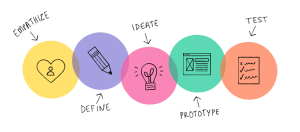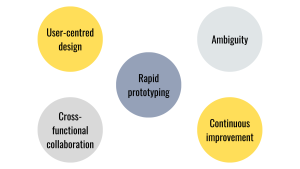content
UI/UX design
March 26, 2024
6 min read
Introduction
The importance of user experience in custom software projects cannot be overstated. However, aesthetics are not enough. In order to truly create quality software that impresses users and effectively solves their problems, implementing design thinking methodologies is essential. Design thinking is a human-centred approach to innovation that puts users at the forefront of the development process. In this article, we explore the ins and outs of incorporating design thinking into custom software projects and explore how it can revolutionise the way software is conceptualised, developed, and deployed.
Understanding Design Thinking
Design thinking is all about empathy, ideas and experimentation. It involves understanding user needs and pain points, brainstorming creative solutions, and rapidly prototyping and iterating based on feedback. Unlike traditional development approaches that prioritise functionality over user interaction, design thinking starts with the user and works backwards to create intuitive and user-friendly solutions.
Design Thinking Process
Design thinking typically follows a structured process that can be broken down into several stages.

- Empathy: The first step involves immersing yourself in the user’s world to gain a deeper understanding of their needs, motivations and problems. This may involve conducting interviews, observations and surveys to collect qualitative data.
- Define: Once user needs are defined, the next step is to translate this information into actionable ideas. This involves synthesising the data gathered during the empathy phase to define the problem statement or opportunity that the software aims to solve.
- Idea: By understanding the nature of the problem, teams can engage in brainstorming sessions to generate a sample of potential solutions. Here, the emphasis is on quantity and creativity in order to explore as many ideas as possible.
- Prototype: After identifying a sample of promising ideas, the next step is to create prototypes to visualise and test these concepts. Prototypes can take many forms, from paper sketches to digital wireframes, depending on the complexity of the software.
- Testing: The final phase involves gathering feedback from users through usability testing and iterating prototypes based on their input. This process allows teams to refine their ideas and ensure that the final product effectively meets user needs.
Incorporating Design Thinking into Custom Software Projects
Consider how design thinking can be integrated into special software projects.

- User-centred design: Design thinking shifts the focus from feature-centred design to user-centred design. Instead of starting with a list of features and capabilities, teams start by understanding user needs and preferences. This ensures that the software solves real problems and provides value to the target audience.
- Cross-functional collaboration: Design thinking emphasises the interdisciplinary collaboration of people with different skills and perspectives. These can be designers, developers, product managers and end users. By stimulating the cooperation of various specialists, design thinking promotes holistic problem solving and innovation.
- Rapid prototyping: Rather than waiting until the end of the development cycle to gather feedback, teams are prototyping early and often to test their ideas. This approach allows for quick experimentation and course adjustments, ultimately leading to better results.
- Ambiguity: Design thinking recognizes that innovation is messy and non-linear. It embraces ambiguity and uncertainty, recognising that the best solutions often emerge through experimentation and failure. Design thinking fosters a culture of experimentation and encourages teams to push the boundaries of what is possible and challenge the status quo.
- Continuous improvement: design thinking is not a one-time activity, but an ongoing process of learning and adaptation. Even after the software has been deployed, teams must continue to collect user feedback and improve the product based on their changing needs. This approach ensures that the software remains relevant and competitive in a rapidly changing landscape.
Conclusion
Applying design thinking to custom software projects can be a game-changer for organisations seeking innovative, user-centric solutions. By putting users at the centre of the development process, teams can create software that not only solves problems, but also delights users. From empathy and ideation to rapid prototyping and iteration, design thinking offers a framework for innovation that can drive success in today’s competitive marketplace. As organisations actively move towards digital technologies, design thinking will play an increasingly key role in shaping the future of software development.
If you have any questions or an idea for a project, contact us via sales@instandart.com or fill out the form on the main page of the site to discuss. We are always ready to help!
